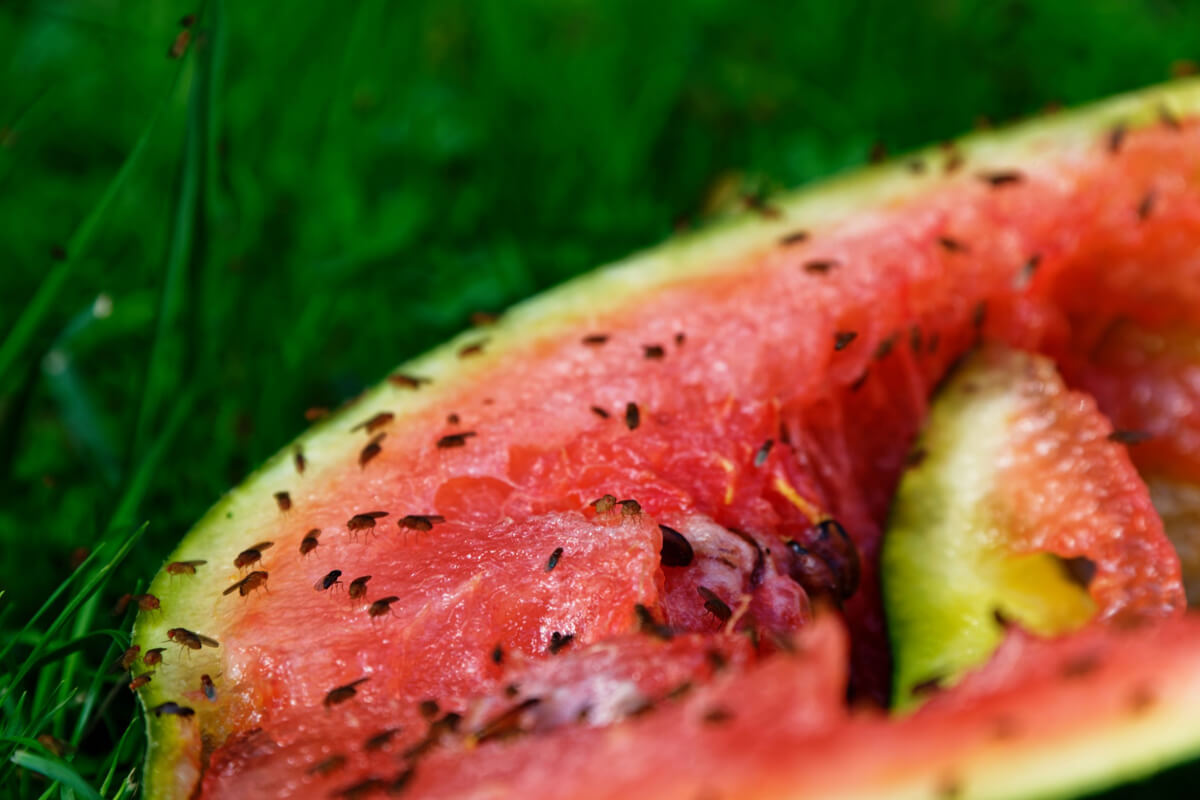Get rid of fruit flies fast by combining effective DIY traps like apple cider vinegar with dish soap, thorough cleaning of breeding areas, and strategic use of natural repellents. The most proven method uses a mason jar with tiny nail holes in the lid, filled with apple cider vinegar and soap, which can capture 50+ flies in just one week.
- What Are Fruit Flies and How to Identify Them
- Most Effective DIY Traps: Apple Cider Vinegar Method
- Rotting Fruit Funnel Trap for Stubborn Infestations
- Cleaning and Drain Control: Eliminating Breeding Grounds
- Modern Commercial Options: Zevo UV Plug-In Traps
- Natural Repellents and Prevention Practices
- Quick Troubleshooting and Best Practices
What Are Fruit Flies and How to Identify Them
Fruit flies are tiny flying pests about the size of a grain of rice with tan or brownish bodies and distinctive red eyes. They’re attracted to sweet fruits, vegetables, and fermented beverages like wine or juice through chemotaxis – their biological attraction to chemical signals from fermenting organic matter.
Fruit flies look like small flies and are typically found near fruit bowls, trash, or other smelly food sources. They differ from drain flies, which look like small fuzzy moths near sinks, and fungus gnats, which resemble small mosquitos and are usually found near houseplants. Female fruit flies can lay up to 500 eggs at once, with eggs hatching within 12 hours and reaching adulthood in just a few days. This rapid reproduction means a few pests can quickly become a full infestation. The scientific name Drosophila melanogaster derives from Greek, meaning “dew-lover” with dark belly, reflecting their preference for moist environments.
Most Effective DIY Traps: Apple Cider Vinegar Method
The apple cider vinegar trap consistently ranks as the most effective DIY solution for fruit fly extermination. This simple method uses ingredients you likely already have at home and represents the gold standard among homemade insect traps.
The clear winner in multiple tests involves taking a mason jar and punching tiny holes in the lid with a hammer and nail, then filling it with 1/4 cup of apple cider vinegar and a few drops of liquid dish soap. This method caught at least 50 flies in one week, far outperforming other DIY options. The dish soap breaks the surface tension, causing flies to sink and drown instead of escaping. Apple cider vinegar smells just like overripe fruit to fruit flies, making it the most attractive bait compared to white vinegar, which isn’t very effective.
Quick Setup Instructions
Create your fly capture device by punching 3-4 tiny holes (about grain-of-rice size) in a mason jar lid using a nail and hammer. Pour in 1/4 cup apple cider vinegar, add 2-3 drops of liquid dish soap, and screw on the lid tightly. The holes allow flies to enter but make escape nearly impossible, creating an effective one-way entry system.
Rotting Fruit Funnel Trap for Stubborn Infestations
For persistent problems, the rotting fruit trap leverages the most natural attractant available and works as part of comprehensive pest management strategies. This method works especially well when combined with vinegar traps for integrated pest control.
Place a chunk of very ripe fruit (apples, peaches, and bananas work well) with apple cider vinegar in a jar. Roll paper into a cone shape with a very small opening at the tip and place it in the jar opening with the narrow end pointing down. The fruit’s natural decay produces powerful attractants, while the funnel design creates a behavioral trap that exploits flies’ inability to navigate upward through small openings. Replace fruit bait every 2-3 days to maintain peak attractiveness and prevent excessive decay.
Cleaning and Drain Control: Eliminating Breeding Grounds
Drain cleaning is essential because fruit flies often breed in the biofilm that builds up inside kitchen drains and garbage disposals. This approach targets the larval stage and represents true source reduction rather than just surface control.
Pour boiling water down your drains regularly to kill any fruit flies breeding inside. You can also use a mixture of 1/2 cup baking soda followed by 1 cup of vinegar, which helps break down organic matter where flies lay eggs. Forid Drain Gel Cleaner is a concentrated microbial degreasing product that quickly breaks down organic waste that builds up in drains, eliminating the fruit flies’ food source and breeding site. Clean your garbage disposal thoroughly and wipe down all surfaces where sweet or sticky residues might accumulate.
Focus on often-overlooked microhabitats like damp sponges, recycling bins with sticky residue, and the area under your sink. Even small amounts of organic matter can support large fly populations, making sanitation the cornerstone of effective control.
Modern Commercial Options: Zevo UV Plug-In Traps
The Zevo Flying Insect Trap represents the latest advancement in fruit fly control, using phototropism – flies’ natural attraction to specific light wavelengths – to continuously capture pests without chemicals or odors.
The Zevo uses specially designed blue and UV LEDs to attract fruit flies, gnats, and house flies to a disposable sticky cartridge. Users report seeing results within 24 hours, with the trap working silently in the background without mess, smells, or noise. The device plugs into any standard outlet and uses adhesive stickers that slide into the back of the unit. When full, you simply replace the cartridge using a no-mess tab.
Key Benefits of UV Traps
Zevo traps are safe to use around pets and children when used as directed, and the disposable cartridges should be checked every 15 days for optimal performance. The blue light is subtle during the day but bright enough to work as a nightlight. For larger rooms or severe infestations, multiple traps may be needed for complete coverage. This represents a shift from reactive control to proactive monitoring.
Natural Repellents and Prevention Practices
Essential oils provide an effective, chemical-free approach to fly deterrence while leaving your home smelling fresh. These botanical repellents work through olfactory disruption rather than killing, representing the opposite approach (repulsion versus attraction) compared to traps.
Peppermint oil stands out as one of the most effective essential oils, with research showing it can achieve 100% repellency against fruit flies for up to six days after application. Other highly effective oils include eucalyptus, lavender, lemongrass, and tea tree oil, each containing specific compounds that disrupt flies’ olfactory senses. Create a natural repellent spray by mixing 10 drops each of eucalyptus and lavender oils with one cup of water in a spray bottle.
Plant-Based Prevention
Growing certain plants near entry points can help repel fruit flies due to their potent aromas. Basil and lavender are particularly effective when placed near doors and windows. You can also soak cotton balls in lemongrass oil and place them around your kitchen, or use essential oil diffusers to maintain a fruit fly-repelling atmosphere throughout your home. This phytochemical defense mimics plants’ natural pest resistance mechanisms.
Quick Troubleshooting and Best Practices
If your traps aren’t working effectively, check these common issues. Trap placement is crucial for success – position them near fruit bowls, garbage cans, and other areas where you’ve seen fly activity, creating strategic interception zones.
Place multiple traps around your kitchen for maximum effectiveness, positioning them near areas where organic matter accumulates. Most traps begin capturing flies within 2-4 hours of placement, with significant reduction in fly activity within 24-48 hours. Ensure trap holes aren’t too large (flies can escape) or too small (they can’t enter). Replace bait every 2-3 days and maintain strict cleanliness by storing produce in the refrigerator and cleaning up spills immediately.
For severe infestations, combine multiple methods in an integrated approach: use both vinegar and fruit traps, clean all drains thoroughly, apply essential oil sprays, and consider adding a UV trap for continuous protection. Proper waste management and sanitation is the single most effective way to keep flies and fruit flies out of a home, with frequent trash removal and container rinsing being essential prevention strategies.
The key to permanent fruit fly control lies in breaking their reproduction cycle through consistent cleaning and strategic trapping. Recent USDA research shows that advanced techniques like male annihilation technique (MAT) and sterile insect technique are revolutionizing fruit fly management, though these professional-grade methods are primarily used for agricultural pest control. With these proven methods, you can eliminate existing flies and prevent future infestations naturally and effectively, transforming your space from a fly-friendly environment to a pest-free zone.





